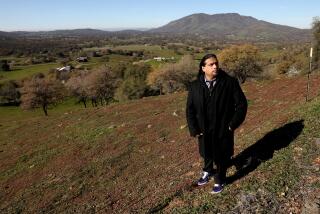Carpinteria school board pares down Native American imagery
- Share via
CARPINTERIA, CALIF. — After the climax of a bitter, yearlong conflict over Native American images at Carpinteria High School, officials on Wednesday issued two orders: Roll up the floor mats emblazoned with a cartoonish Indian head and cease giving out athletic patches with the image of a glowering red man.
But, in a victory for traditionalists, the school will retain all the other Native American likenesses and symbols that dot the campus where residents have cheered on their Warriors since 1928.
The decision came late Tuesday night after a heated school board meeting that drew hundreds to the school gym, whose outer wall is painted with a mural of a headdress-clad chief surrounded by student athletes. Board members, one of whom survived a recall attempt over the issue, decided in a 3-2 vote to keep the mural, a bust of a Plains Indian chief and an array of other images.
The conflict has roiled the seaside town since last March, when a student of Chumash descent told the board that the images demeaned his heritage. Similar debates have rocked school districts across the country for decades.
On Wednesday, the campus was placid but the issue was far from settled nationally.
“You don’t have a single state that’s passed an anti-imagery or antimascot law and there’s not a single beacon Supreme Court case,” said Paul Cordeiro, superintendent of Carpinteria’s schools. “I sometimes wonder if I wouldn’t welcome a final resolution to this in some way.”
The board rejected most of the recommendations from an advisory committee it had appointed. Among other things, the committee suggested purging the district’s logo of an Indian head, a canoe and arrowheads, leaving a sunset and a shield.
For two hours, residents trooped to the microphone Tuesday night, some charging racism as others denounced political correctness run amok.
Many said the images were meant to honor Native Americans, not demean them. While other embattled schools have mascots clad in Indian regalia, it has been many years since a similar figure made an appearance at a Carpinteria High game or other event.
Some speakers charged that the board’s 15-member advisory committee was stacked with anti-imagery activists.
“Outside agitators have tried to turn it into a major spectacle,” said retired teacher Langdon Nevins.
Many spectators waved signs that read: “Warrior Spirit Never Dies!” The crowd cheered 76-year-old Evangelina Diaz, a resident of Yaqui descent, who proclaimed she was “a warrior, not a victim!”
On the other side were people supporting Eli Cordero, the student who triggered the controversy. Cordero, a 16-year-old junior, told the board that the images made inappropriate use of Native American likenesses and ceremonial items.
“I’ve looked into the eyes of the stone Indian and seen the degradation of my ancestors,” he said, referring to the concrete statue of a chief in the school parking lot.
Faviana Hirsch, a member of the board’s Native American Imagery Committee, suggested the cause may be considered by federal authorities “under Barack Obama, who has called for change in this country -- if some of you people in Carpinteria haven’t noticed.”
In preparing security measures for the tense hearing, the school board conferred with the U.S. Justice Department, which had personnel in department polo shirts patrolling the perimeter of the crowded gym. Santa Barbara County sheriff’s deputies also kept watch.
Before the hearing, Native American activists drummed and chanted outside. Many had come from elsewhere, contending that the imagery had a damaging effect well beyond Carpinteria. Inside the gym, a man paced the sidelines, displaying a poster with pennants of fabricated teams such as “the Fighting Jews” and “the San Francisco Orientals.”
“What’s your team?” he asked the crowd.
At issue were 13 separate images that appear on stickers, patches, T-shirts and elsewhere. The Warriors’ name was not in dispute because it appeared ethnically neutral to many people who were upset by the images.
The board last spring voted 3 to 2 to remove the images but backed down after a community outcry. On Tuesday, board chairwoman Terry Hickey Banks agreed with critics who said they had acted too quickly.
“A slower, more educational process would have resulted in less anger,” she said.
--
More to Read
Sign up for Essential California
The most important California stories and recommendations in your inbox every morning.
You may occasionally receive promotional content from the Los Angeles Times.











